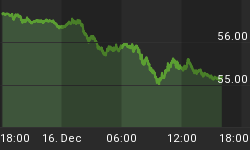
Source: www.stlouisfed.org
One has to wonder what all the fuss is about that has seen homebuilder shares in the US soar 11% (as measured by the iShares Dow Jones US Home Construction (ITB-NYSE)) in 2013 thus far and a 78% in 2012. The chart above shows actual sales of new homes and that shows that despite all of the hoopla new homes are simply not selling. That certainly has not stopped construction though as the chart below demonstrates.

Source: www.stlouisfed.org
Housing starts, unlike sales of new homes is actually rising. A closer examination of both though shows a market that remains depressed when compared with the performance over the past 50 years. New home sales are as low as they were in the mid-1960's while new housing starts are only marginally above where they were at the bottom of the early 1980's and early 1990's recessions.
Yet if one listens to the pundits' and the homebuilders ETF one would think that the US was in the midst of a huge housing boom. The picture is somewhat similar here in Canada although the drop in housing starts is nowhere near as drastic. Where it shows is that housing starts in relation to population growth is actually slowing not growing.
So what is driving this? Wealthy immigrants? Certainly they are playing a role but then they also tend to buy high end homes and condominiums. So what else? Is economic growth causing housing starts to grow? Hardly. GDP growth according to www.shadowstats.com has actually been negative since the start of the 21st century (the blue line on the chart below). Even the official headline GDP (the red line on the chart below) has been tepid at best. Q4 GDP was reported at negative 0.1%. On that basis, economic growth does not appear to be driving growth in housing starts.
During the 1990's the baby boomer generation drove the housing market. However, as the generation ages odds are more of them will be downsizing as their now growing kids move out. From 2000 to 2005, cheap mortgages drove the market. However, that era is also over as lenders tightened their requirements. That is assuming they can find credit worthy consumers to lend to. Quite simply lenders are not lending. Or is it borrowers are not borrowing. Mortgages outstanding in the US peaked in Q1 2008 just over $10.6 trillion. As of Q3 2012, outstanding mortgages had fallen to $9.5 trillion.

Source: www.shadowstats.com
The supply of homes available for sale has fallen. The most recent numbers indicate there is only 4.9 months' supply. Is down sharply from the over 12 months' supply that was seen at the bottom of the 2009 recession. It is estimated that there remains some 10.8 million homes in the US that are worth less than their outstanding mortgage. This represents some 22% of all homes. This remains a drag on the market as it is effectively existing housing for sale even if they do not put it up for sale. The homeowners can't afford to move as they would lose too much money.
Yet the US administration once again appears to be willing to expand mortgage financing programs through the bankrupt Fannie Mae (FMNA-OTCBB) and Freddie Mac (FMCC-OTCBB). This is not much different from what got the housing markets in trouble in the first place in the mid-2000s with sub-prime loans and other mortgage methods. That ended badly and almost brought down the financial system. The markets are still trying to recover from that "debacle". The Fed is now onto its third round of quantitative easing (QE) in an attempt to stimulate the economy.
What the current round of QE does is purchase $85 billion a month of securities. The securities are mortgage backed securities (MBS) of possibly questionable value as well as US Treasuries. Similar programs under different guises are being carried out by the ECB in the Euro zone as well as the BoJ in Japan. The programs are designed to put money into the financial system that is "hopefully" loaned out. The QE program also goes a long way to keeping interest rates low, even artificially low.
Simply put interest rates cannot rise because the US, Japan and the Euro Zone are overwhelmed with debt and even a half a percentage point rise in interest rates would cost the governments billions of dollars to be added to budget deficits. Budget deficits are 3.3% of GDP in the Euro Zone, 7% of GDP in the US and 9.8% of GDP in Japan. Debt as a percentage of GDP is very high for Japan at 212% of GDP, for the US at 101.6% of GDP and for the Euro Zone at 87.3% of GDP. Canada is at 85% of GDP. On the other hand, China's debt to GDP is only 25.8% and Russia is even lower at just under 10% of GDP.
In the interim, those who may own homebuilder stocks may wish to take a good look at their profits. It would seem that given a weak economy, high inventories of unsold houses, sales of new homes not matching the excitement in building new homes and a stock market most likely fueled by QE that the risks are now becoming considerably higher.
















